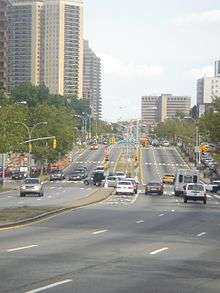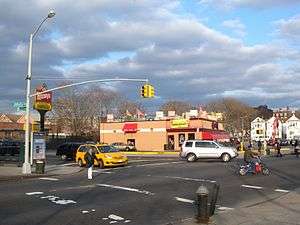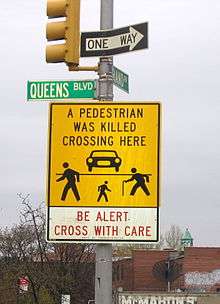Queens Boulevard
 A view down Queens Boulevard, near its intersection with Yellowstone Boulevard in Forest Hills. | |
| Location | Queens, New York City, New York |
|---|---|
| West end |
|
| Major junctions |
|
| East end | Jamaica Avenue, 89th Avenue, and 138th Place in Jamaica |
Queens Boulevard is a major thoroughfare in the New York City borough of Queens connecting Midtown Manhattan, via the Queensboro Bridge, to Jamaica. It forms part of New York State Route 25.
Route

Queens Boulevard runs northwest to southeast across a little short of half the length of the borough, starting at Queens Plaza at the Queensboro Bridge entrance in Long Island City and running through the neighborhoods of Sunnyside, Woodside, Elmhurst, Rego Park, Forest Hills, Kew Gardens, and Briarwood before terminating at Jamaica Avenue in Jamaica. At 7.2 miles (11.6 km), it is one of the longest roads in Queens, and it runs through some of Queens' busiest areas. Much of the road is 12 lanes wide, and at its intersection with Yellowstone Boulevard in Forest Hills, it reaches a high point of 16 lanes. Along much of its length (between Roosevelt Avenue and Union Turnpike), the road includes six express lanes (three in each direction) and a three-lane-wide service road on each side. Drivers must first exit to the service road in order to make right turns or pull over; left turns must be made from the express lanes, but only at select cross-streets. It is known as the Boulevard of Death.[1] More crashes happen along Queens Boulevard than any other roadway statewide.[2][3]
Queens Boulevard is also the starting point of a number of the other major streets in Queens, such as Northern Boulevard, Woodhaven Boulevard, Junction Boulevard, Roosevelt Avenue, and Main Street.
History

The route of today's Queens Boulevard originally consisted of Hoffman Boulevard and Thompson Avenue,[4] which was created by linking and expanding these already-existing streets, stubs of which still exist. A remnant of the old Hoffman Boulevard can be found in Forest Hills where the local lanes of traffic diverge into two routes, one straight and one that bends around MacDonald Park. The part that bends around the park was the original route of Hoffman Boulevard. The street was built in the early 20th century to connect the new Queensboro Bridge to central Queens, thereby offering an easy outlet from Manhattan.
In 1913, a trolley line was constructed from 59th Street in Manhattan east along the new boulevard. During the 1920s and 1930s the boulevard was widened in conjunction with the digging of the IND Queens Boulevard Line subway tunnels in the 1920s and 1930s. The new subway line used cut-and-cover construction and trenches had to be dug up in the center of the thoroughfare, and to allow pedestrians to pass over the construction, temporary bridges were built. The improvement was between Van Dam Street and Hillside Avenue, and it cost $2,230,000. The street was widened to 200 feet between Van Dam Street and Union Turnpike, and from there to Hillside Avenue it was widened to 150 feet. As part of the project, there was to have been separated rights-of-way for the trolley line.[5][6] On April 17, 1937, trolley service along Queens Boulevard ended, being replaced by bus service.[7] In 1941, the New York City Planning Department proposed converting it into a freeway, as was done with the Van Wyck Expressway from the Queensboro Bridge to Hillside Avenue. The boulevard would be converted to an expressway with grade separation at the more important intersections, and by closing off access from minor streets. As part of the project, the express lanes of Queens Boulevard were depressed in the area of Woodhaven Boulevard and Horace Harding Boulevard (later turned into the Long Island Expressway), while the local lanes were kept at grade level. The plan to upgrade the boulevard was delayed with the onset of World War II, the plan was never completed.[6]
Transportation
This street hosts one of the highest numbers of New York City Subway services in the city. The E F M R (IND Queens Boulevard Line) and the 7 <7> N W (IRT Flushing Line) all use stretches of the right of way; only Broadway (eight services), Sixth Avenue (seven) in Manhattan and Fulton Street (eight) in Brooklyn carry more at any one time. In addition, the Q60 bus travels its entire length, and the Q32 and Q59 buses travel for significant potions of the boulevard's length.[8]
For a few decades streetcar service operated along the boulevard and until 1957 operated along the sides of the Queensboro Bridge into Manhattan.[9][10] For the section where the line ran congruent with the Flushing IRT elevated line the streetcars ran in a median below the viaduct supporting the elevated trains. In the space of the present-day Aviation High School, there was a train yard for the streetcars.[7][11]
Boulevard of Death reputation
The combination of Queens Boulevard's immense width, heavy automobile traffic, and thriving commercial scene made it by the 1990s the most dangerous thoroughfare in New York City and has earned it city-wide notoriety and morbid nicknames such as "The Boulevard of Death"[12] and "The Boulevard of Broken Bones."[13] Its width is comparable to that of Ocean Parkway and Linden Boulevard in Brooklyn; the Grand Concourse and Bruckner Boulevard in the Bronx; Richmond Avenue in Staten Island; and Park Avenue and Delancey Street in Manhattan. Some of the most dangerous crossings of Queens Boulevard are near Roosevelt Avenue, 51st Avenue, Grand Avenue, Woodhaven Boulevard, Yellowstone Boulevard, 71st Avenue, and Union Turnpike, due to the fact that most of these streets cross the boulevard diagonally.

Between 1980 and 1984, at least 22 people died and 18 were injured in a 2.5-mile (4.0 km) stretch of Queens Boulevard. In 1985, the New York City Department of Transportation started a project to examine the causes of fatalities and injuries on the boulevard.[14] From 1993 to 2000, 72 pedestrians were killed trying to cross the street, or an average of 10 per year.[15] Since 2000, at least partially in response to major news coverage of the dangerous road, the city government has taken measures to cut down on such incidents, including posting police along parts of the boulevard and doing spot-ticketing stings of jay-walkers against traffic, posting large signs proclaiming that "A Pedestrian Was Killed Crossing Here" at intersections where fatal accidents have occurred and installing more road-rule enforcement cameras. There were over 36 deaths between 2003 and 2013. In 2004, only one pedestrian was killed crossing Queens Boulevard.[16]
In 2011, safety enhancements, including pedestrian signals that count the time left to cross the street, were implemented. That year was the first year that no one was killed crossing the street.[17] In 2015, a new initiative was announced to improve Queens Boulevard at a cost of $100 million.[18] The section between Roosevelt Avenue and 73rd Street received new safety improvements, including pedestrian zones and bike lanes, as part of improvement's Phase 1, which began in August 2015 and was finished by the end of the year.[13][19] Phase 2 began in summer 2016, while Phase 3 is expected to begin in 2017.[20][21] The whole corridor is to be improved by 2018 and the whole boulevard will eventually be totally overhauled.[13][19]
| Year | Killed |
|---|---|
| 1990 | 18[22] |
| 1991 | 13[22] |
| 1992 | 5[22] |
| 2001 | 4 |
| 2002 | 2 |
| 2003 | 5 |
| 2004 | 1 |
| 2005 | 2 |
| 2006 | 2 |
| 2007 | 1 |
In popular culture
- In the HBO original series, Entourage, main character Vince stars in a fictional film named Queens Boulevard in which he is able to identify with the source material as an original resident of New York. To further understand the story frame, it is important to note that in real life the four leading actors portraying Vince, Eric, Johnny, and Turtle all actually grew up in New York.
- In the movie Coming to America, the address of McDowell's restaurant is 85-07 Queens Boulevard in Elmhurst, which was formerly a Wendy's fast food restaurant but is now a new housing development.
- Dukes Boulevard in the video game Grand Theft Auto IV is based on Queens Boulevard.
- A short-lived sitcom entitled 13 Queens Boulevard, aired on ABC-TV in 1979.
- On The Mindy Project Morgan says to Dr. Lahiri that if it weren't for her, he'd be "working at the fake Popeye's on Queens Boulevard".
- In the movie Cruel Intentions, the main characters of Sebastian Valmont (Ryan Philippe) and Annette Hargrove (Reese Witherspoon) are seen driving along Queens Boulevard in the beginning and end credits respectively
References
- ↑ Paul Mullins (October 29, 2012). "The boulevard of death: Ghost bikes and spontaneous shrines in New York City". PopAnth.com. Archived from the original on December 27, 2013.
- ↑ "The New York City Pedestrian Safety Study & Action Plan" (PDF). New York City Department of Transportation. August 2010.
- ↑ "Addressing an Elderly Pedestrian Crash Problem in New York City". Center for problem-Oriented Policing.
- ↑ "Town of Newtown, Queens County. Long Island - Woodside". 1873. Retrieved April 19, 2011.
shows Thompson Ave. on south border of map
- ↑ See Flickr album:
- "Office of the President, Borough of Queens, Topographical Bureau Map Showing Roadway Treatment of Queens Boulevard From Van Dam St. To Hillside Ave. In Connection With The Proposed Improvement New York, January 31, 1922". Flickr. Retrieved 2016-08-04.
- "Office of the President, Borough of Queens, Topographical Bureau Map Showing Roadway Treatment of Queens Boulevard From Van Dam St. To Hillside Ave. In Connection With The Proposed Improvement New York, January 31, 1922". Flickr. Retrieved 2016-08-04.
- "Office of the President, Borough of Queens, Topographical Bureau Map Showing Roadway Treatment of Queens Boulevard From Van Dam St. To Hillside Ave. In Connection With The Proposed Improvement New York, January 31, 1922". Flickr. Retrieved 2016-08-04.
- "Office of the President, Borough of Queens, Topographical Bureau Map Showing Roadway Treatment of Queens Boulevard From Van Dam St. To Hillside Ave. In Connection With The Proposed Improvement New York, January 31, 1922". Flickr. Retrieved 2016-08-04.
- "Office of the President, Borough of Queens, Topographical Bureau Map Showing Roadway Treatment of Queens Boulevard From Van Dam St. To Hillside Ave. In Connection With The Proposed Improvement New York, January 31, 1922". Flickr. Retrieved 2016-08-04.
- "Office of the President, Borough of Queens, Topographical Bureau Map Showing Roadway Treatment of Queens Boulevard From Van Dam St. To Hillside Ave. In Connection With The Proposed Improvement New York, January 31, 1922". Flickr. Retrieved 2016-08-04.
- "Office of the President, Borough of Queens, Topographical Bureau Map Showing Roadway Treatment of Queens Boulevard From Van Dam St. To Hillside Ave. In Connection With The Proposed Improvement New York, January 31, 1922". Flickr. Retrieved 2016-08-04.
- "Office of the President, Borough of Queens, Topographical Bureau Map Showing Roadway Treatment of Queens Boulevard From Van Dam St. To Hillside Ave. In Connection With The Proposed Improvement New York, January 31, 1922". Flickr. Retrieved 2016-08-04.
- "Office of the President, Borough of Queens, Topographical Bureau Map Showing Roadway Treatment of Queens Boulevard From Van Dam St. To Hillside Ave. In Connection With The Proposed Improvement New York, January 31, 1922". Flickr. Retrieved 2016-08-04.
- "Office of the President, Borough of Queens, Topographical Bureau Map Showing Roadway Treatment of Queens Boulevard From Van Dam St. To Hillside Ave. In Connection With The Proposed Improvement New York, January 31, 1922". Flickr. Retrieved 2016-08-04.
- 1 2 "Queens Boulevard Express Highway (NY 25, unbuilt)". www.nycroads.com. Retrieved 2016-08-04.
- 1 2 Meyers, Stephen L. (2006-01-01). Lost Trolleys of Queens and Long Island. Arcadia Publishing. ISBN 9780738545264.
- ↑ Queens bus map, MTA.info. Retrieved August 5, 2016.
- ↑ "Queensborough Bridge Railway terminal" Abandoned Stations site
- ↑ "Queens of the Thirties" Archived May 9, 2012, at the Wayback Machine. Lost Magazine
- ↑ "Queens Trolleys in the 1930s: Queens Plaza and Queens Blvd." on YouTube
- ↑ "Boulevard of death' claims another life". WABC Television. April 9, 2009. Retrieved April 10, 2009.
- 1 2 3 "Upcoming Redesign Will Make "Boulevard of Death" Safer, DOT Says". NBC New York. Retrieved October 9, 2015.
- ↑ "Current Trends Queens Boulevard Pedestrian Safety Project -- New York City". Centers for Disease Control and Prevention. February 10, 1989. Retrieved October 9, 2015.
- ↑ "A pedestrian is killed in Queens every 6 weeks on the BOULEVARD OF DEATH". NY Daily News. January 11, 2001.
- ↑ "VIOLENT CITY DEATHS HIT HISTORIC LOWS Everything from murders to auto fatalities falls sharply". NY Daily News. January 2, 2005. Retrieved April 10, 2009.
- ↑ "NYC DOT - NYC DOT Installs Countdown Signals on Queens Boulevard, the Latest in a Year of Unprecendented Safety and Mobility Enhancements Boroughwide". nyc.gov.
- ↑ Queens Boulevard Safety Improvements, nyc.gov (March 2015)
- 1 2 Fermino, Jennifer (April 1, 2015). "Queens 'Boulevard of Death' to get $100 million renovation to improve safety". NY Daily News. Retrieved April 1, 2015.
- ↑ Parry, Bill (August 4, 2016). "DOT begins Phase 2 of the Queens Blvd. project in Elmhurst". Times Ledger. Retrieved 2016-08-04.
- ↑ Giudice, Anthony (July 28, 2016). "More street safety repairs for Queens Boulevard". www.timesnewsweekly.com. Times Newsweekly. Retrieved 2016-08-04.
- 1 2 3 Faison, Seth (January 3, 1993). "Pedestrians at Risk On Queens Boulevard". The New York Times. The New York Times Company. Retrieved December 28, 2015.